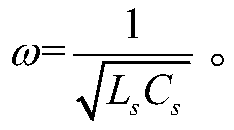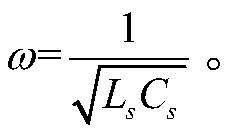LCC-S topology, wireless power transmission system and harmonic content suppression method
A wireless power transmission, LCC-S technology, applied in harmonic reduction devices, AC networks to reduce harmonics/ripples, current collectors, etc. Complexity and other problems, to reduce the high-order harmonic content, the fundamental wave component is not affected, and the effect of reducing the burden on the power supply
- Summary
- Abstract
- Description
- Claims
- Application Information
AI Technical Summary
Problems solved by technology
Method used
Image
Examples
Embodiment 1
[0032] combine figure 1 , the present invention mentions an LCC-S topology suitable for a wireless power transfer system, the left side is the transmitting end circuit of the wireless power transfer system, and the right side is the receiving end circuit of the wireless power transfer system. The transmitter circuit contains a voltage source U 1 , compensation inductance L p , Transmitting coil L t , and compensation inductance L p The first compensation capacitor C in series f , and the transmitting coil L t The third compensation capacitor C in parallel p , the transmitting coil L t There is a second compensation capacitor C in series t . The receiving end circuit includes the receiving coil L s , and receiving coil L s The fourth compensation capacitor C in series s , R in the figure L Indicates the load.
[0033] At the transmitting end of the wireless power transfer system, each inductance and capacitance meet the following conditions:
[0034] ω L p -1 / (ωC...
Embodiment 2
[0043] As another embodiment of the present invention, the present invention also provides a wireless power transmission system, which adopts the aforementioned LCC-S topology.
Embodiment 3
[0045] As yet another embodiment of the present invention, the present invention also provides a harmonic content suppression method for a wireless power transmission system, using the aforementioned LCC-S topology, and adjusting the compensation inductance L at the transmitting end according to the system frequency ω p value, so that it satisfies the following conditions: ωL p -1 / (ωC f )=1 / (ωC p )=ωL t -1 / (ωC t ).
[0046] Aspects of the invention are described in this disclosure with reference to the accompanying drawings, which show a number of illustrated embodiments. Embodiments of the present disclosure are not necessarily defined to include all aspects of the present invention. It should be appreciated that the various concepts and embodiments described above, as well as those described in more detail below, can be implemented in any of numerous ways, since the concepts and embodiments disclosed herein are not limited to any implementation. In addition, some aspe...
PUM
 Login to View More
Login to View More Abstract
Description
Claims
Application Information
 Login to View More
Login to View More - R&D
- Intellectual Property
- Life Sciences
- Materials
- Tech Scout
- Unparalleled Data Quality
- Higher Quality Content
- 60% Fewer Hallucinations
Browse by: Latest US Patents, China's latest patents, Technical Efficacy Thesaurus, Application Domain, Technology Topic, Popular Technical Reports.
© 2025 PatSnap. All rights reserved.Legal|Privacy policy|Modern Slavery Act Transparency Statement|Sitemap|About US| Contact US: help@patsnap.com



